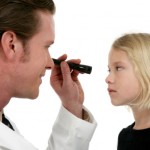SERVICES
For Kids

Why get an eye exam?
Babies are able to see as soon as they are born. For the visual system to continue to develop properly, children need clear input from both eyes to the brain.
If there is a problem that interferes with vision in either eye or both eyes, the connections from the eye to the brain can become weak or not develop properly. Crossed or turned eyes or an imbalance in the way each eye focuses can interfere with this normal development of vision.

Questions you will be asked?
A child’s eye exam begins by discussing any problems the parents recognize. It is important to find out if there were problems with the pregnancy or with the child’s birth, and if the child’s growth and development are proceeding normally. A history of eye problems in the family is important. The ophthalmologist needs to know about the child’s health in general. Are there any medical problems? Has the child had any treatment with medications or any surgical procedures?
If your child has been treated with medications, glasses, or contact lenses, these should be brought to the exam. The names and addresses of other physicians who may be treating the child should be supplied so that they may be informed of the findings of the eye exam.

Lights, lights, lights!
Lights are used to examine the pupils to see if the eyes are working properly. During this portion of the exam, the areas around the eyes such as the eyelids and the tear ducts are also examined. A tiny flashlight can also be used to check whether the child’s eyes are straight or turned.
Sometimes, one eye is covered and then the other. If the eyes are not aligned properly, they will jump back and forth when looking at the light or toy. Wedge-shaped pieces of clear plastic called prisms can be used to measure the amount of misalignment of the eyes.

Why use eye drops?
One of the less enjoyable but most essential parts of the exam is the dilation of the pupil. This not only allows the ophthalmologist to view the inside of the eye but the drops temporarily relax the child’s focusing power so that nearsightedness, farsightedness, or astigmatism (all referred to as refractive errors) can be accurately measured.
Most doctors have preferences for the eye drops that they use. Some drops are given once, some more than once, and all take about 20–30 minutes to be effective. For some children, for their revisit exams, it may be necessary to have a special drop or ointment put in their eyes at home before coming into the exam.

What happens after the drops?
Whether your child is attentive or not at this point, or even if he/she is asleep, the focus of the eye can be measured. The ophthalmologist uses small lenses and a special flashlight called a retinoscope to measure whether the child is nearsighted, farsighted, or has astigmatism.
It is a somewhat different technique from that which ophthalmologists use to fit glasses for adults, but it is still very accurate. This tells us if your child needs glasses.

How are the insides of the eyes checked?
Once your child’s pupils are dilated, your ophthalmologist can get a very good look at the inner eye structure to make sure the eye is healthy.
The inside of the eye holds the retina which is like the film of a camera, recording the images focused by the front of the eye and sending them to the brain by the optic nerve. The optic nerve itself, as well as the blood vessels that supply the retina, can be seen in the back of the eye. Special instruments allow the inside of the eye to be seen clearly.

For adults
Most Pediatric Ophthalmologists are also Adult Strabismologists. We are recognized as experts in the treatment of adult strabismus and other eye conditions such as amblyopia. Adults with a history of childhood amblyopia or strabismus should be seen every 2–3 years to ensure that their alignment is still normal. There are also cases where adults develop misalignment of their eyes or double vision at an older age.
We can often successfully treat patients with non-surgical techniques. However, should the need arise, we perform the most updated surgical techniques including adjustable suture surgery.
Read more about Adult strabismus.
